Banner campaign
Latest

Basic Needs Assessment Guidance & Toolbox Part 2: How-to Guide & Tools
Guidelines and Tools
This How-to Guide is Part 2 of the BNA Guidance & Toolbox, with Part 1 describing the background and concepts underpinning the BNA approach.
The How-to Guide describes the sequence of practical steps necessary to ensure a successful BNA during emergencies, from initiation of the BNA up to reporting and...

Assessing the effects of a combined economic and social intervention in Uganda on child protection and economic outcomes
Presentation
Presentation showing preliminary findings from USAID-funded Aspires Family Care Project, implemented by FHI360, ChildFund International and AVSI. Economic strengthening activities including cash transfers, VSLAs, matched savings accounts and others were shown to reduce families’ economic vulnerability...

Social Protection and Humanitarian Response: What is the Scope for Integration?
Guidelines and Tools
Given the rise in humanitarian emergencies triggered by climate-related risks and conflict, often in contexts of chronic poverty and vulnerability, the international community is calling for the better integration of short-term humanitarian assistance and longer-term development interventions. In this...
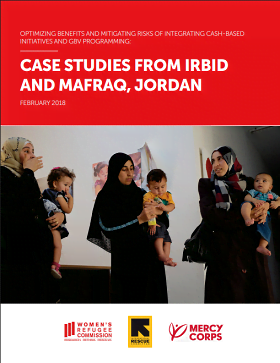
Optimizing Benefits and Mitigating Risks of Integrating Cash-Based Initiatives and GBV Programming: Case Studies from Irbid and Mafraq, Jordan
Report
This case study provides an overview of assessment and monitoring activities
conducted by Mercy Corps and the International Rescue Committee in partnership with the Women’s Commission to:
a. mainstream gender-based violence (GBV) considerations in cash-based interventions
b. utilize cash within a GBV...

Taking Market Analysis Beyond Theory: Practices that Facilitate the Use of Market Information in Humanitarian Programming
Guidelines and Tools
Although strong examples of emergency programming that considers and responds to local market dynamics are out there, they are relatively few in number, and there is no consolidated review of these programs to inform good practice. Under the Improving the Uptake of Market Analysis project, a...
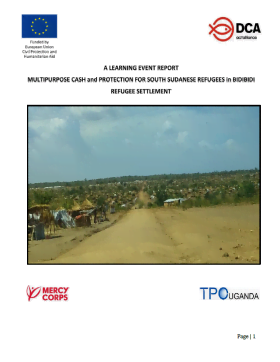
Multi-purpose Cash and Protection for South Sudanese Refugees in Bidibidi Refugee Settlement: A Learning Event Report
Report
This paper will present evidence on how cash transfers empowers conflict affected populations. The evidence is based on two projects implemented by DCA in Bidibidi Refugee Settlement in Uganda. Furthermore, the paper present evidence on how the two projects successfully linked cash and protection. 14, 520...
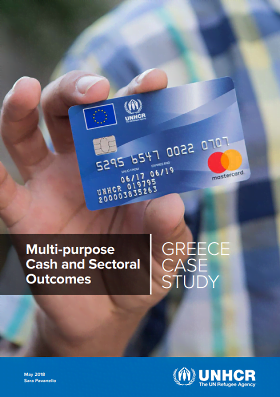
Multi-purpose Cash and Sectoral Outcomes – Greece case study
Report
Starting in 2015, the European Commission has been providing funding to support the humanitarian response in Greece through the Emergency Support to Integration & Accommodation’ (ESTIA) programme managed by its European Union Civil Protection and Humanitarian Aid (ECHO). ESTIA is implemented by UNHCR...
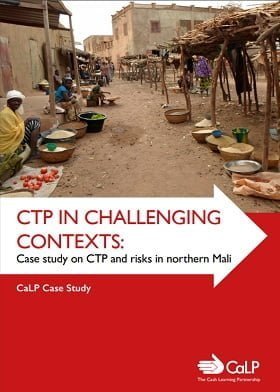
CTP in Challenging Contexts: Case study on CTP and risks in northern Mali
Report
This case study was commissioned by the the CALP Network as the first output under the 2018–2019 workstream on cash transfer programming (CTP) and associated risks. The study aims to contribute to the body of evidence on CTP-related risks and mitigation strategies by drawing lessons learnt and...

Can limited-term cash transfers confer (lasting) child protection benefits?
Presentation
The USAID-funded Aspires project, implemented by FHI360, ChildFund International and AVSI, developed evidence and programming guidance on how economic interventions can facilitate the reintegration of separated children into families, and also prevent unnecessary separation of children from their families.

E-Voucher – Electronic Voucher – Cash Based Programming
Guidelines and Tools
Last Mile Mobile Solutions, LMMS E-Voucher Electronic Solution
The Electronic Voucher provides the ability to:
– Deliver cash programmes to beneficiaries through transfer of electronic vouchers
– Enables full end-to-end digitalized tracking of transactions
– Increases security of the transfers
–...

Cash Transfer Programming in the Education and Child Protection Sectors: Literature review and Evidence maps
Report
The use of cash transfer programming (CTP) in humanitarian response continues to increase in scale and quality, as evidenced by the State of the World’s Cash Report.
This report examines the body of research that provides evidence of the impact of CTP on education and child protection outcomes and...

MPCA in Iraq: Perspectives of beneficiaries on impact
Report
Cash Transfer Programmes (CTP) have become a common feature of humanitarian responses in conflict and disaster settings, supported by a wealth of evidence that cash transfers are an effective means of meeting humanitarian needs, providing local markets are functioning and accessible. CTP without...

Cash Transfer Programming in Somaliland
Report
This report brings together reflections from a one-day learning event which took place in Hargeisa in March 2018. Participants reflected on what aspects of cash transfer programming worked well in the 2017 response and what needs to be improved going forward. In addition, there was a discussion about the...

Understanding Market Drivers in Syria
Report
Study conducted by the SIM Consortium (Syria Independent Monitoring) in partnership with iMMAP, commissioned by DFID (report initially released in January 2018). This report documents the findings of an in-depth assessment of the olive/olive oil and spice/herb market systems in northeastern and...
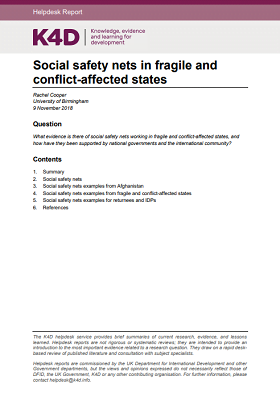
Social Safety Nets in Fragile and Conflict-Affected States
Report
This rapid review synthesises evidence on social safety net in fragile and conflict-affected states and how they have been supported by national governments and the international community. First section will discuss about the scope of social safety net and followed by examples from Afghanistan. Second...

E-Transfer implementation guide
Guidelines and Tools
This updated E-transfer Implementation Guide replaces the original guide published in 2014. In cash transfer programming (CTP), electronic transfers (e-transfers) are a digital replacement for paper vouchers or physical cash. E-transfers are a disbursement mechanism – a way of transferring money, goods...
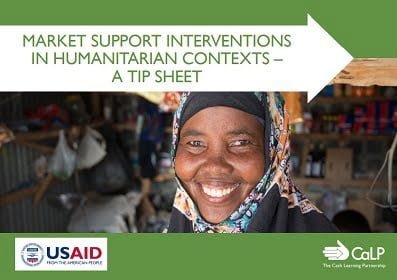
Market Support Interventions in Humanitarian Contexts – a Tip Sheet
Guidelines and Tools
This tip sheet defines what market support programming in humanitarian contexts is, and what it can look like in practice. It enables humanitarian practitioners to systematically consider market support interventions alongside other programme activities. The scope includes support interventions focusing...

Cash Transfer Programming in Armed Conflict: The ICRC’s Experience
Report
Money is the main means of survival for most people around the world. That remains the case in situations of armed conflict, when having cash to buy essential goods can mean the difference between life and death.
The ICRC’s experience shows that cash is an essential tool in humanitarian action in armed...

Cash Impact on Food Security and Non-Food Outcomes: Ministudy I
Report
To better understand how different amounts and frequencies of cash transfer impact household food security outcomes and non-food outcomes (food well-being, financial well-being, ability to cope with shocks and stresses and household well-being), this study adopted a randomised control design with two...
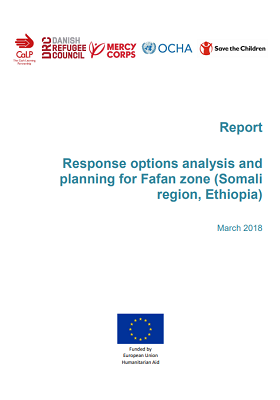
Response options analysis and planning for Fafan zone (Somali region, Ethiopia)
Guidelines and Tools
Between October 2017 and March 2018, the Consortium began the pilot in Ethiopia with the aim of providing technical and strategic support to country-based humanitarian organisations, enabling them to engage in collaborative assessments and decision making. Whilst the Consortium has not been conceived to...